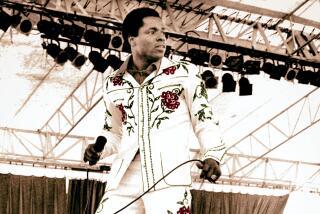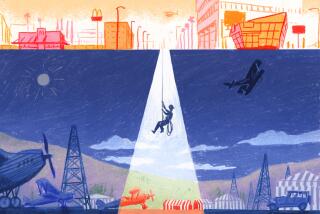Seemingly Fearless Aviation Pioneer Was a Mama’s Boy at Heart
- Share via
Southern California aviation pioneer Glenn Luther Martin started his design career as a child -- snipping up his mother’s bedsheets to build sails and kites. Whatever her reaction at the time, she became his biggest supporter as he designed and tested the nation’s first twin-engine bomber and built a company that would become Lockheed Martin Corp.
The Wright brothers’ famous flight on Dec. 17, 1903, spawned a pantheon of aviation heroes and corporate legends -- including Martin, who built Southern California’s first airplane in 1909.
Martin seeded the aerospace industry with some of its biggest names: Lawrence Bell, who later built America’s first jet, was his first shop foreman; Donald Douglas was his first engineer and William Boeing was one of his student pilots. Martin was also one of America’s greatest tycoons -- and almost certainly the only one to live with his mother.
Martin was born in Iowa in 1886 and grew up in Kansas, where his father owned a hardware store.
Fascinated with flying at an early age, he began building box kites on his mother’s kitchen floor, then sold them to local kids for a quarter -- on an installment plan. Always experimenting, he cut up his mother’s bedsheets and fashioned sails for his wagon and bicycle, to propel him faster through the wheat fields. He did the same thing on ice skates, creating an early version of para-sailing.
In 1905, the Martins moved to Santa Ana. While his father, Clarence, parlayed his profits into Ford and Maxwell automobile dealerships, young Martin tinkered as a mechanic.
Soon after the family settled here, Martin’s mother, Minta, had the family doctor declare her 19-year-old daughter, Della, a mentally ill “religious fanatic.” Della was committed to a San Gabriel Valley sanitarium for life.
Little is known about his father, except that he died in 1935. But Martin’s mother would shape her son’s life. “It was my mother who encouraged me to believe in myself,” Martin said in 1943.
Awed by the Wright brothers and other stick-and-rudder aviators, Martin began building his own pusher-type biplane in an abandoned Methodist church in Santa Ana. With the help of a few mechanics and his mother, he painstakingly pieced it together with curved bamboo ribs and neatly stitched white muslin. He fitted the biplane to a 15-horsepower Model V Ford engine. His mother made herself at home in the cockpit by his side, becoming her son’s constant companion and the only woman in his life until the day she died.
His first test flight nearly launched him heavenward -- but not in the way he’d planned. In the summer of 1909, he rolled the biplane four miles down the road to the Irvine Ranch, where he gave the propeller a spin.
Before he could climb into the cockpit, the engine roared to life and began pulling the pilotless craft across the field. The propeller sliced through his jaunty bowler hat as he grabbed the plane and rode it like a bronco through a series of dizzying circles. Finally, a wheel collapsed and the plane’s framework crunched in a heap.
Martin wasn’t easily discouraged. Weeks later, on Aug. 1, 1909, he donned another bowler hat and cranked up the engine again. This time, he lifted the craft 8 feet into the air, flying 100 feet in 12 seconds.
“We did it,” he was quoted as saying. “Now I’m going home and sleep for about 20 hours.”
He continued to use the pasture in exchange for free flying lessons for James Irvine Jr., known as J.I. With the financial backing of his friend, Frank A. Garbutt, an industrialist, movie pioneer, writer and inventor, Martin and his mother formed the Glenn L. Martin Co., opening an airplane factory in a former peach cannery near the old church.
He also raised capital on his own by performing daredevil stunts for the film industry, running a flying school in Griffith Park -- where William Boeing was his student -- and barnstorming at circuses and fairs as the “Flying Dude.”
On May 10, 1912, Martin made history: He added pontoons to the bottom of his airplane, the Avalon Zipper, and piloted it from Balboa to Catalina Island. His flight time, at 3,500 feet, was 37 minutes. After landing, he ate a sandwich, refueled and patched a hole in his wing. On his return flight he carried the day’s mail from Catalina -- another first.
He was an overnight sensation, and began blazing new trails in air express by carrying a bundle of Fresno Republican newspapers to Madera, 24 miles away.
That same year, he moved his manufacturing plant to Los Angeles at 9th and Los Angeles streets, now the site of the California Market Center. There, he began to design and build military planes.
In 1913, Martin hired Georgia “Tiny” Broadwick, a 4-foot 8-inch daredevil, to demonstrate his pack-type parachute, the Martin Life Vest, which he hoped would be to aviation what lifejackets were to sea travel. Broadwick became the first female skydiver, thrilling spectators as she parachuted from a plane.
In 1914, months before the outbreak of World War I, more than 12,000 flight enthusiasts, film companies and Army personnel gathered at the Pomona Valley fairgrounds, now the Fairplex, to watch Martin, 28, test-fly his new “army scout,” a military training plane. He staged a mock bombardment, dropping live explosives on a ground target and demonstrating air-to-ground radio communications.
There was only one mishap: The day before, Martin’s 75-pound dynamite bomb prematurely exploded, destroying his biplane -- which he had left to retrieve his gloves. Undaunted, he drove to Los Angeles and returned with a spare plane.
It was the fairgrounds event, dubbed the “Battle of the Clouds,” that helped Martin’s career take off. He won contracts to build the first armored planes and military training planes, which would distinguish his role as an aircraft manufacturer.
By 1917, before the end of World War I, he would be the largest airplane manufacturer in the country and one of the main suppliers of military and commercial aircraft, employing 150 workers.
From planes to show biz, he was always the showman, even though he feared women more than engine trouble. In 1914, he navigated his green Stoddard-Dayton to a horse barn in Hollywood, where he was paid $700 a day to play a roguish pilot opposite Mary Pickford in the film “The Girl of Yesterday.” But when it came to the kissing scene, Martin cringed. “I don’t think my mother would like it,” he said off-screen, according to Wayne Biddle in his 1991 book “Barons of the Sky.”
Despite his public persona of daredevil pilot and screen rogue, many of his employees were perplexed by his eccentricities -- including that he neither smoked, drank nor swore. Donald Douglas, who designed the Model S seaplane for Martin, called him a “strange chap,” but marveled at his agility and coordination.
In 1917, Martin moved east, briefly merging his company with the Wright Co. But within a few months he was frustrated by Orville Wright’s leadership style and moved to Cleveland. There, he founded the second Glenn L. Martin Co. and began building the MB-1, the first twin-engine American bomber, which could carry a bomb load of 1,500 pounds. By the late 1920s, he moved the company to Middle River, Md., where he built a larger factory to design seaplanes that could be tested on ice-free water on the Chesapeake Bay.
Between world wars, he built the B-10 bomber, the China Clipper, the giant seaplane Mars and the B-26 Marauder bomber.
When his mother died in 1953, Martin donated a $40,000 organ and tower bells in her memory to the First Presbyterian Church of Santa Ana. He arranged to have the bells rung each hour on weekdays and to play a hymn at 5 p.m. Their caroling still signals the close of each workday in the town.
It wasn’t until Martin died in 1955 that efforts were made to secure freedom for his sister, who was by then a wealthy woman: Martin had left her $10 million. In 1957, Della, 73, was declared sane. But she suffered from “cultural underexposure”: For the more than 50 years that she had lived in the sanitarium, she had never been allowed to wear shoes. No one knows why.
When she died in San Marino in 1974, at the age of 90, a foundation promoting research into mental illness was established in her name. In 1992, nearly two decades later, the Della Martin Center for Behavioral Services opened at Huntington Memorial Hospital in Pasadena.
More to Read
Inside the business of entertainment
The Wide Shot brings you news, analysis and insights on everything from streaming wars to production — and what it all means for the future.
You may occasionally receive promotional content from the Los Angeles Times.










